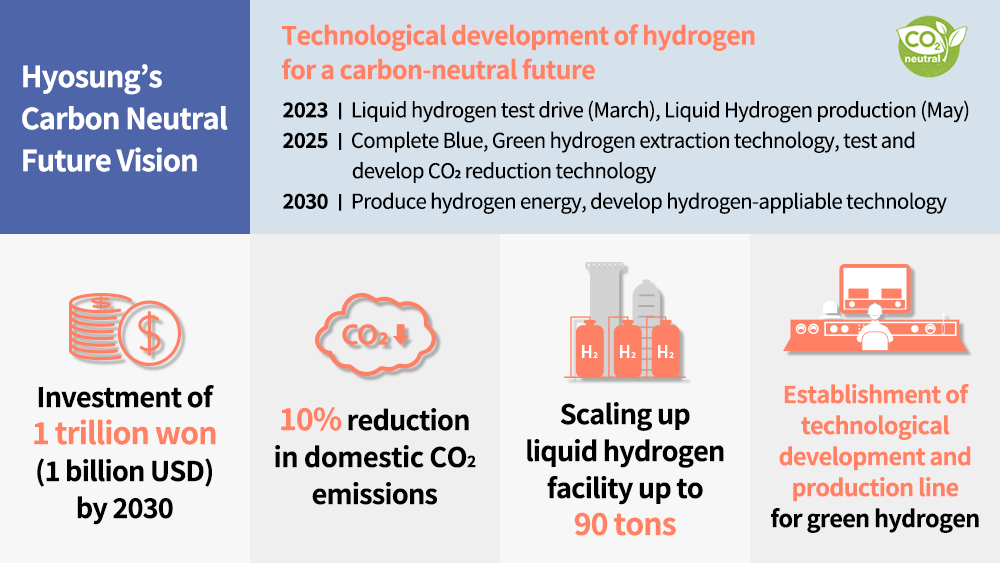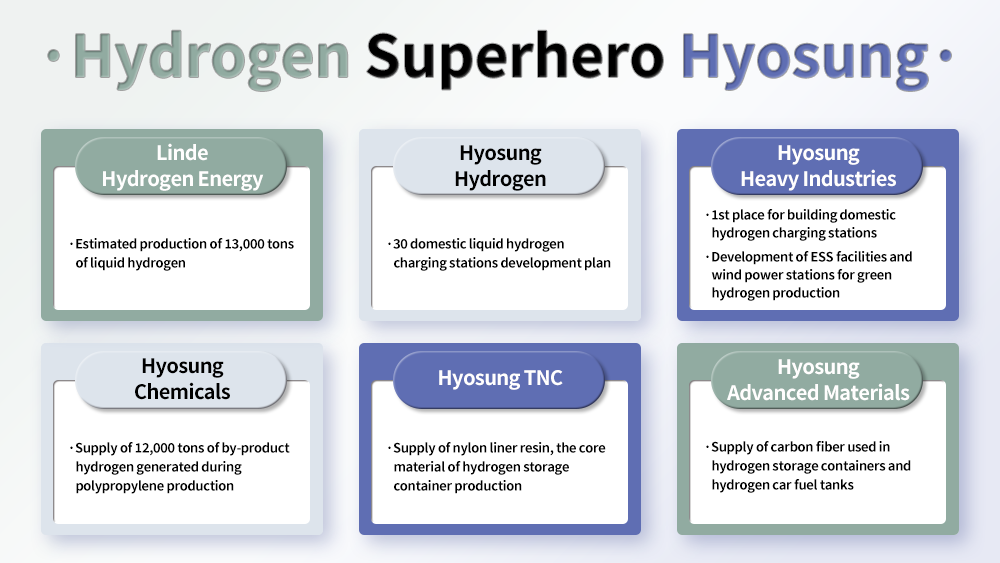Brand Journalism
Brand Journalism
2023-01-16
Efforts to Curb Temperature Rise Below 1.5 Degrees, the Danger Line for Global Warming
Leaders from across the world gathered in Paris in December 2015. Their nationalities and cultures differed, but they had a single goal in mind: To curb temperature rise caused by global warming.
There had been numerous meetings of the Conference of the Parties to the United Nations Framework Convention on Climate Change before this one, but they all had ended without any resolution due to conflicting interests. However, this time was different, because everyone at the table knew what was at stake: the imminent and urgent necessity of addressing climate change.
With the Paris agreement adopted, the world is pulling together to curb down the temperature rise to below 1.5 °C. Hyosung as a global citizen is also playing its part. It is envisioning a carbon neutral future by promoting hydrogen, a clean energy source.

By 2025, Hyosung plans to secure hydrogen production technologies driven by blue and green hydrogen that emits lower or zero greenhouse gas in a bid to build a clean hydrogen ecosystem. Based on such technologies, development and demonstration of carbon-reduction technologies will be pursued accordingly. By 2030, a total of 1 trillion Won (equivalent to 1 billion USD) will be invested to achieve technological self-sufficiency when it comes to development and utilization of hydrogen energy. This is also expected to help Korea reduce carbon emission by 10%. To this end, key affiliates of Hyosung Group are putting efforts to build the hydrogen value chain of production, storage, distribution, supply and consumption.
Why is holding global warming to 1.5 °C such a big deal?
1.5 Degrees, the Danger Line for Global Warming

According to the ‘Special Report on Global Warming of 1.5 °C’ released by Intergovernmental Panel on Climate Change (IPCC) in 2018, a 1.5°C global warming above pre-industrial levels will put the humanity as a whole and our home planet Earth in grave danger.
Can you imagine the North Pole without ice? A 1.5°C average temperature rise would increase the probability of an iceless summer to every 100 years. A 2°C rise would mean the probability increase to once every ten years. An iceless Arctic Ocean will absorb a larger proportion of sunlight and in turn further accelerate global warming. This will mean higher temperature, more frequent heavy rain and flooding. If an iceless North Pole meets with heavy rain, it will lead to sea level rise to inundation of coastal residential areas.
Marine ecosystems will be no exception. Especially, habitat-forming species such as coral reefs compared to their mobile counterparts will take the hardest hit. A 1.5°C rise in temperature could wipe out as much as up to 90% of coral reefs in the world. Without coral reefs, maritime biodiversity will be significantly destroyed which will then affect the world’s fish ecosystem. It is expected the global overall fish catch will decline 150,000 tons per annum.
Remember the dire heat waves and droughts that hit around the globe last summer? A 1.5°C rise is estimated to bring such deadly heat waves to 14% of the global population at least once every five years. While we hesitate, the global temperature is fast approaching a 1.5°C rise. If we do not take action now, what was taken for granted will disappear very quickly, and there will only be regrets when the nature and ecosystem are destroyed.
Let’s take a look at how Hyosung is partaking in building a carbon-neutral future driven by hydrogen.
Hyosung, a Hydrogen Superhero

Affiliated companies of Hyosung have been pulling together to commercialize hydrogen to replace fossil fuel, in order to build the hydrogen value chain of production, storage, distribution, supply and consumption.
Liquid hydrogen is at the front line of Hyosung’s such efforts. As one of the largest industrial conglomerates in Korea, Hyosung has partnered with a global gas name Linde to jointly build Hyosung Hydrogen and Linde Hydrogen Energy.
Linde Hydrogen Energy which will be responsible for production of hydrogen is to build the world’s largest liquid hydrogen facility with an annual capacity of 13,000 tons with an aim to kick off in May 2023. This facility will process enough hydrogen to fuel 100,000 cars. Hyosung Hydrogen will be leading the global expansion and distribution of the hydrogen production with an aim to expand its liquid hydrogen refueling stations up to 30 by the time the facility is built.
The main driver of the entire hydrogen businesses pursued at the conglomerate is Hyosung Heavy Industries. Based on its experience of building a nation-wide network of CNG filling stations since 1999, the company has been the leading player in domestic hydrogen refueling stations. As of today, it has built 25 hydrogen gas stations across major cities in the country with 16 more in pipeline. Hyosung Heavy Industries is also a leader in wind power turbine and ESS. Its 50MW capacity ESSs require top notch technology as they are often directly connected to important facilities such as national grid and large-scale factories. Hyosung Heavy Industries supplies ESS to major electricity names from England and South Africa.
Hyosung Chemical is responsible for production of hydrogen gas. It sells 12,000 tons of hydrogen gas extracted during the process of propylene, the key material for plastic production. Starting from next year, Hyosung Chemical is to supply liquid hydrogen jointly with Linde. When liquefied, hydrogen gas volume is reduced to 1/800, making storage easier and storage capacity larger. In turn, liquid hydrogen refueling stations require only 30% of the space required for hydrogen gas stations. All in all, supply of this by-product hydrogen with price competitiveness is expected to facilitate a hydrogen economy.
Hyosung TNC and Hyosung Advanced Materials supply materials required for hydrogen storage tanks. Nylon for tank liners from Hyosung TNC and carbon fiber for tank structure from Hyosung Advanced Materials are critical for safe hydrogen transportation. Carbon fiber is also used in fuel tanks in hydrogen vehicles.
Time to get used to charging, not refueling
A future where we fill our cars not with gasoline or diesel but with hydrogen at gas stations is just around the corner. It will not end there. Electricity supplied to homes and buildings will be based on hydrogen, while fossil fuel power stations will be replaced with hydrogen fuel cell power plants. This will significantly cut down emission of air pollutants into the air. Steel mills will also be able to produce steels on carbon-free hydrogen energy.
We already have witnessed how changes can bring about positive results amid the pandemic. Border lockdowns led to economy contraction but ironically the pandemic improved our environmental situations. Less vehicle travels and lower industrial production meant lower emission of greenhouse gas, carbon dioxide and air pollutants. According to the World Meteorological Organization, since the pandemic PM2.5 (fine particular matters) have declined as much as 40% in Africa, South Americas and South Asia.
Hyosung hopes the clean blue sky we enjoyed during the pandemic is here to stay. In the face of the villain greenhouse gas that is inflicting the world, our superhero Hyosung continues on its fight to prevent global warming from reaching a 1.5 °C rise.